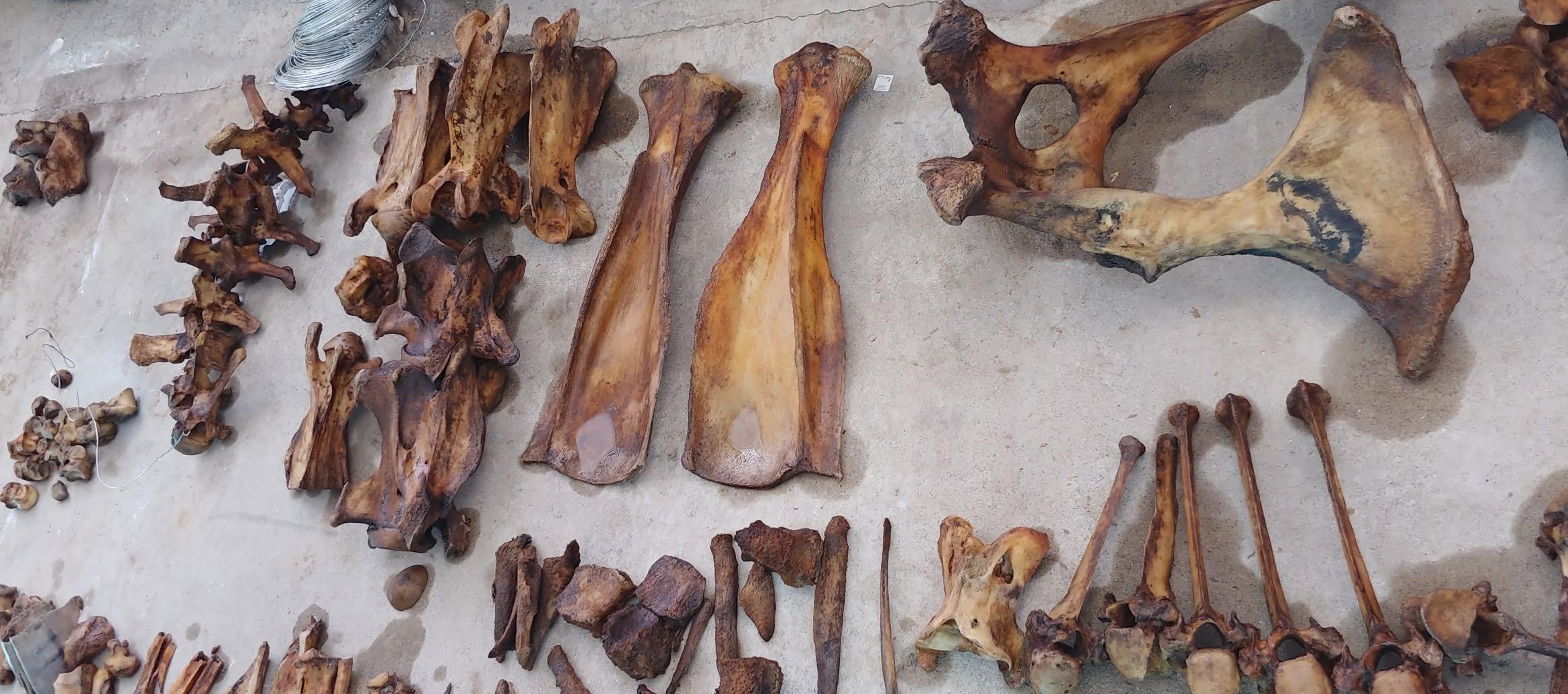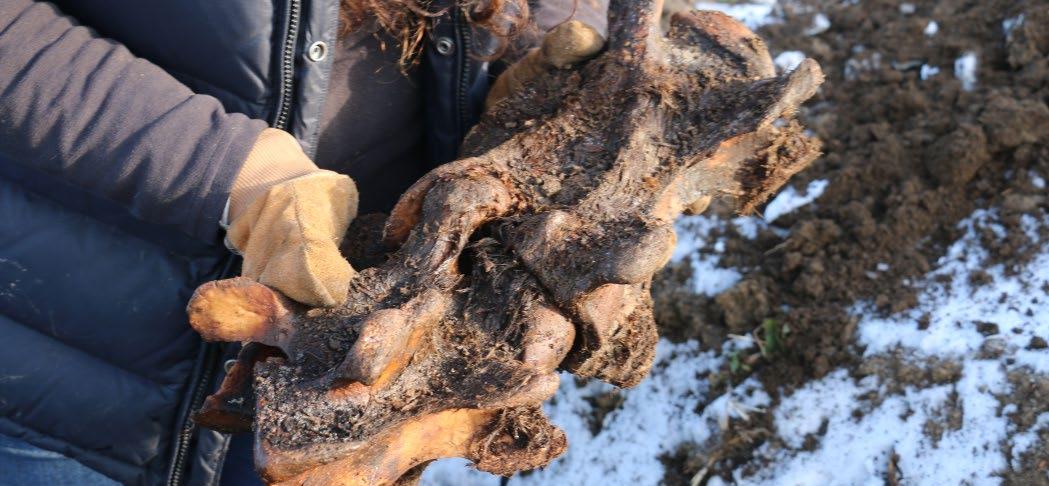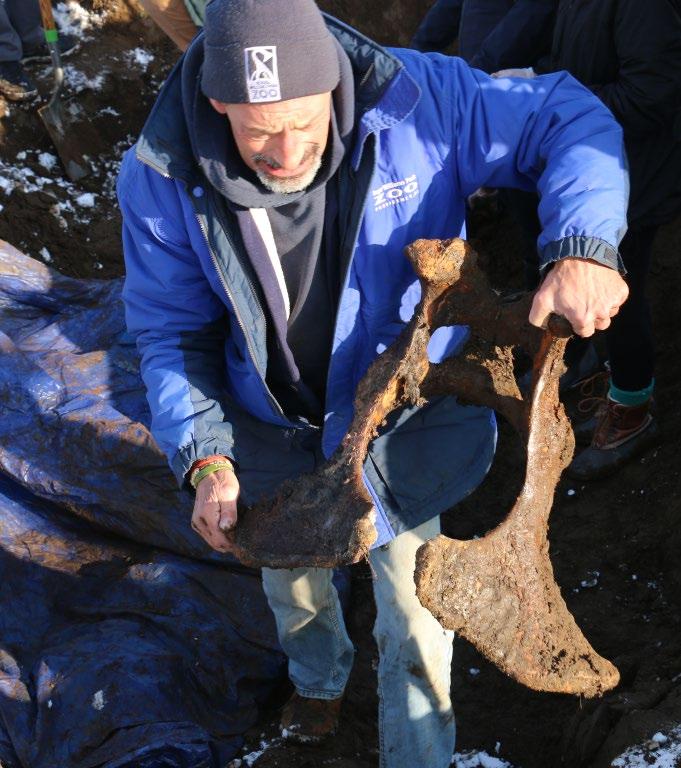
4 minute read
Griffy
It’s 8:00 AM on a cold December morning. A group of students stand gathered in a snowy field on the University of Rhode Island (URI)
campus, some 25 miles south of Roger Williams Park Zoo (RWPZ). The quiet of the crisp morning air is broken only by the dull crunch of
shovels chipping away at the frosty soil. Suddenly, a voice calls out: “I think I found a rib!”
Eager students gather around in awe as the long, thin rib bone is pulled from the soil. Within a few hours’ time (and with the help of some
heavy machinery) nearly all the pieces of a hulking skeleton are laid out on the field.
The subject of the morning’s dig: Griffy, an adult male Masai giraffe and longtime resident of Roger Williams Park Zoo.
Griffy was born in 1989 at the National Zoo in Washington, D.C. and first came to RWPZ the following year. For the next 21 years, Griffy called the Zoo’s Plains of Africa exhibit home.
In his time in Providence, Griffy sired a total of 10 offspring with mates Sukari and Amber. While many of the offspring were sent off to other AZA institutions, the youngest, Jaffa, still lives at the Zoo.
Griffy passed away in March of 2011 and was buried on the URI campus so his skeleton could later be used as an aid in educating the next generation of animal scientists.
According to Lou Perrotti, RWPZ’s director of conservation programs, sometimes there is a silver lining to the tragedy of a zoo animal death: an otherwise scarce opportunity to study exotic specimens firsthand.
After Griffy’s passing, institutions across Rhode Island clamored and competed to get their hands on the giraffe’s remains for zoological research programs.
“I remember there was a big fight over that skeleton,” said Perrotti. “But in the end, we decided to donate it to the University of Rhode Island as a teaching tool.” Griffy was buried in a plot of land on campus and left for nearly 6 years in order to give the body tissue time to break down and decompose.
The partnership between the Zoo and URI says Professor of Animal Science Dr. Jason Richard, is mutually beneficial in a number of ways. As part of this partnership, Dr. Richard teaches a Zoo Animal Management course, an immersive class that gives students a behind-the-scenes look at the care and consideration that goes into the operations of a zoo.
“Through engagement with aspiring animal care professionals,” he said, the relationship “enables students to develop knowledge and skills that they can apply in their future careers, while enriching their experience as undergraduates with unique hands-on learning opportunities.”
In December, an eager group of student volunteers joined Perrotti and Richard for a truly unique opportunity: digging up Griffy’s remains.

“When it was decided that it was time to dig up the skeleton,” said Richard, “I mentioned it to the Zoo Animal Management course, and 17 students volunteered to come out in the cold first thing in the morning just to be a part of the excavation.”
Richard said as part of a proposed independent research project, a team of students from various departments and backgrounds may now have the opportunity to piece Griffy’s skeleton back together.
“The team would be challenged to create a multimedia display that would not just show off the skeleton, but also utilize the specimen as a tool to teach viewers of the display about giraffe biology and to communicate the important roles that zoos like RWPZ play in wildlife education, research, and conservation in today’s society.”

According to Richard, the project would teach the students skills important to their scientific studies including collaboration, communication and scholarly research.
But it will not be a simple task.
“This will require research into not just the anatomy, but also the logistics of the rearticulation,” he said, “from cleaning the bones to ultimately displaying them. This will likely require collaboration with students and faculty in Animal Science, Biology, Wildlife Conservation Biology, and Engineering.”
Perrotti said this sort of project serves to underscore the tremendous impact that zoo animals – that Griffy, gone for almost a decade now - is still teaching and motivating scientists today.
“Even after they’re gone,” he said, “the information that we gather from these animals is used not only to better care for animals in captivity but also as valuable intel for conservation initiatives worldwide.”

“It’s remarkable,” Richard added, “to think about how an animal who inspired so many thousands of Zoo visitors in life can continue to serve as an ambassador for his species for many years to come.”


